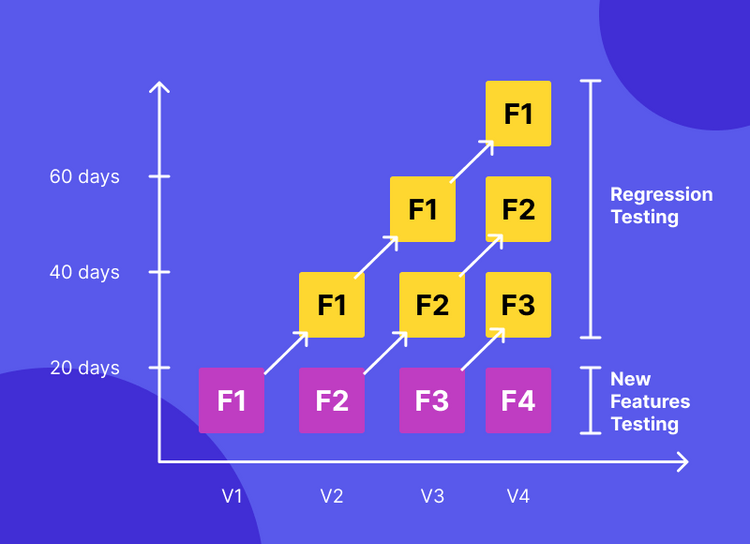What Is Regression Testing? Definition, Examples & Tools
Learn with AI
In modern software development, "moving fast" is the goal, but "breaking things" is a luxury few teams can afford. Every time a developer pushes a bug fix, an optimization, or a shiny new feature, they risk inadvertently breaking a feature that was working perfectly five minutes ago.
This is where Regression Testing becomes your safety net. In this guide, we’ll explore how to build a regression strategy that doesn't just catch bugs but actually accelerates your release cycle.

What is Regression Testing?
Regression testing is the practice of re-running existing test cases to ensure that recent code changes haven't negatively impacted established functionality. When a change in the "Discount" module accidentally breaks the "Payment" gateway, you’ve hit a regression.
A Real-World Example: The Discount Code Dilemma
Imagine you’re managing an e-commerce platform called VeryGoodEcommerce. Your app is stable; users can browse, search, and pay without a hitch.
Then, you roll out a "Discount Code" feature. It works great in isolation, but behind the scenes, the new logic accidentally breaks the "Inventory Update" trigger. Suddenly, you're selling items that aren't in stock. Regression testing would have caught this by re-verifying the core inventory features after the discount code was integrated, rather than just testing the new button.
The Comparison Guide: Understanding Where Regression Fits
To master regression testing, you must understand where it sits in the broader QA landscape. It is often confused with other testing types, but its intent is unique.
1. Retesting vs. Regression Testing
While both involve running tests again, they answer two different questions:
- Retesting (Verification): "We found a bug. Did the developer actually fix it?" (Focuses on the specific failure).
- Regression (Side Effects): "The bug is fixed, but did that fix break anything else in the system?" (Focuses on the broader stability).
2. New Feature Testing vs. Regression Testing
Think of these as the two pillars of any release. One looks forward, the other looks backward.
| Aspect | New Feature Testing | Regression Testing |
|---|---|---|
| Primary Goal | Validate that new code meets requirements. | Validate that existing code still works. |
| Scope | Narrow and deep (specific to the change). | Broad (covering core stable features). |
| Timing | Performed during initial development. | Performed after integration or bug fixes. |
| Automation | Often manual (code is still shifting). | Highly recommended (code is stable). |
Should Regression Testing Be Automated?
The short answer is yes. While manual testing is essential for exploring new features or checking UX "feel," regression testing is repetitive by nature. This makes it the perfect candidate for automation.
The Banking Example: The Cost of Manual Slowness
Consider a banking app that updates its "Currency Exchange" rates. To release this small update, a manual tester might spend 4 hours checking login security, account balance displays, and money transfer functionality just to be safe. If you update the app twice a week, that’s 8 hours of human labor spent just "checking old stuff."
Automation with something like TrueTest turns those 4 hours into 5 minutes of background processing. This allows your team to focus on finding complex bugs in the new currency feature rather than clicking the "Login" button for the thousandth time.
📝 Read More: Complete Guide to Automated Regression Testing
Why Bother? Benefits and Hard Truths
The Benefits
- Prevents Cascading Failures: Catches the "ripple effect" where a small UI tweak breaks a backend database call.
- Enables Agile Velocity: Gives developers the confidence to refactor code without fear of a total system collapse.
- Supports CI/CD Pipelines: Automated regression tests act as safety gates, ensuring each integration is stable before it reaches production.
The Challenges
- Maintenance Heavy: As your app evolves, so does your suite. Keeping scripts updated with UI changes is a constant task.
- The Time Sink: Without automation, regression becomes a major QA bottleneck as the project grows.
- Risk of Overlooking Bugs: Under tight timelines, it’s easy to miss small regressions in complex systems.
When Is Regression Testing Done?
Regression testing is typically triggered by:
- New feature introductions or requirement updates.
- Bug fixes and code optimizations.
- Third-party system integrations or configuration changes.
- UI/UX updates or patch releases.

How to Do Regression Testing: A 6-Step Framework
- Detect Source Code Changes: Identify exactly what changed—was it a fix, an enhancement, or a config update?
- Impact Analysis & Prioritization: Focus on the components most likely to break. Prioritize by business criticality and frequency of use.
- Define Entry and Exit Points: Ensure the environment is stable before starting (Entry) and define clear quality standards for completion (Exit).
- Categorize Test Cases: Group tests by type (functional/non-functional) and decide what stays manual (exploratory) versus what gets automated (repetitive).
- Environment Preparation: Ensure your test environment mirrors production to avoid false positives/negatives.
- Execute and Measure: Run your tests and analyze the results. Comprehensive analytics help you quantify the effectiveness of your strategy.

For example, in Katalon TestOps, teams can access dashboards that highlight testing efficiency and defect density after every run.

Balancing New Features with Regression
The biggest struggle for QA leads is deciding where to spend limited resources. Alex Martins, a veteran with 20+ years in software quality, shares how to maintain this balance when the dev team is moving at full speed:
Regression Testing Best Practices
- Prioritize High-Risk Areas: Focus on the "crown jewels" of your app—features that would stop a user's journey if they broke.
- Automate Wisely: Manual regression is slow and error-prone. Use tools to automate repetitive high-impact tests.
- Maintain Your Suite: Regularly prune outdated tests and update scripts to stay relevant with the UI.
- Shift Left: Integrate regression into your CI/CD pipeline to catch bugs the moment code is integrated.
- Parallel Testing: Run tests across multiple browsers and OSes simultaneously to reduce execution time.
Top Regression Testing Tools for 2026
1. Katalon

Katalon helps teams automate regression for web, API, and mobile apps without starting from scratch. It bridges the gap between manual and automated testing with its Keyword Library and low-code capabilities.
2. Selenium

The open-source standard for web testing. It is incredibly powerful but requires significant coding expertise to maintain. Ideal for teams with dedicated SDETs.
3. Playwright

A modern framework known for its speed and "auto-waiting" features, making it a favorite for testing modern web applications built on React or Vue.
for more of a deep-dive into our guide on the best regression tools for 2026.
Conclusion
Regression testing is more than just a safety check; it’s the foundation of user trust. By balancing the excitement of new features with the stability of a robust regression suite, you ensure your product remains solid as it scales.
|
Regression Testing FAQs
1. What is regression testing?
Regression testing is the process of re-running existing tests after code changes to ensure that new updates, bug fixes, or enhancements do not break existing functionality. It verifies system stability and consistency after modifications in the software.
2. Why is regression testing important?
Regression testing is essential because even small code changes can cause unexpected issues elsewhere in the application. It ensures software reliability, supports Agile and CI/CD workflows, and helps catch regressions early before release, preventing costly production bugs.
3. When should regression testing be performed?
Regression testing should be done whenever the codebase changes — such as after bug fixes, new features, UI updates, configuration changes, patch releases, or third-party integrations. It confirms that the existing features still behave as expected after updates.
4. Should regression testing be automated?
Yes. Regression testing is highly repetitive, predictable, and ideal for automation. Automated regression tests speed up execution, improve accuracy, and integrate seamlessly into CI/CD pipelines. However, manual regression testing is still valuable for exploratory or visual validation.
5. What are the best tools and practices for regression testing?
Top tools include Katalon Studio, Selenium, and Watir, each supporting automated regression test suites across web, API, and mobile apps.
Best practices include:
-
Prioritizing critical test cases
-
Automating repetitive tests
-
Maintaining and updating the test suite regularly
-
Running regression tests continuously in CI/CD pipelines
-
Using parallel testing to save time


.png)